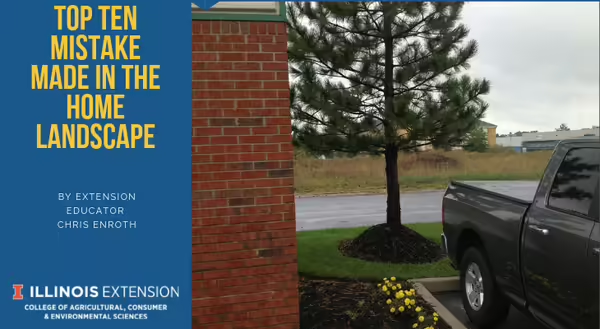
Spring is certainly in the air. It seems we finally had our first nice day of the year, with highs in the low 70s and sunshine warming the soil as daffodils and crocus burst forth and begin to flower. Spring also brings the weekend warriors. After being trapped indoors for months on end, we Midwesterners are brushing off the mowers, blowers, and loppers.
Our anxiousness to get outside often comes with some common mistakes in the landscape. Little mistakes can lead to a gardener's frustration. Big mistakes can lead to the loss of a prized tree. The list is long, but I've narrowed it down to my top ten mistakes many people make in the home landscape.
- The first twenty years of a tree's life is determined by the first twenty minutes it spends in your yard. Proper tree planting is critical to the long-term success of our beloved shade trees. When planting a balled-and-burlap tree, it is important to remove the wire basket once you get it to the planting hole. Then loosen the burlap and use that lift the tree in the hole. Once the tree is in the planting hole, remove as much burlap as possible. Don't leave it on!
- When planting your tree, make sure the root flare is above the soil line. The root flare is where the trunk flares out into the root system. If the tree looks like a telephone pole sticking out the ground, it is planted too deep.
- Keep mulch away from the trunk. Mounding mulch against the trunk (also known as volcano mulching) is a terrible practice that could lead to damage and rot around the base of the tree. Mulch rings should be as wide as possible, 2 to 4-inches deep, with a 2-inch gap around tree trunks.
- Tree topping turns your tree into a hazard to you and anything underneath. Don't top your tree. Enough said!
- Those golf course fairways sure do look nice clipped low to the ground. Why does your lawn look so terrible when you cut it that short? Because golf courses have huge budgets, work crews, and someone with a degree in turf management. Our cool season lawns grows best at a taller cut height. Mow at a height of 2 to 3 inches to get a dense lawn that can outcompete the weeds.
- So many people have told me they've already put grass seed down in March. That's too early for our area in Central Illinois! Wait at least until April when soils begin to warm. The best time of year to seed a lawn is the late summer to early fall. Sod is recommended in the spring.
- Sharpen those mower blades! Dull blades don't cut grass they, beat, shred and tear lawns. At a minimum, sharpen your blades at least once a year. The sharper the better!
- With spring comes the desire to freshen up the mulch. Before putting new mulch on top of old mulch break up the mulch with a cultivator or hard-toothed rake. This breaks the shell that can form over time, especially with shredded mulch. Cultivating mulch improves water and air movement to the soil.
- Leave the dandelions alone! Dandelions are a great source of pollen and nectar for our early season pollinators. If you must treat your yard for dandelions, wait until late summer to early fall. Treating in the spring won't stop the dandelions from germinating throughout the growing season, and you'll just have more of the same next year.
- Fall leaves are not waste! Why buy mulch when you have access to fall leaves? Shred them up and use them in place of mulch. Or compost them to create gardener's black gold!
I have made plenty of mistakes and killed lots of plants. It is all a learning experience. With everything that can go wrong in the landscape, this was a tough list to narrow down to ten. What common mistakes do you encounter? Feel free to leave a comment or reach out to me with your common landscaping mistakes.
Good Growing Tip of the Week: Extension offers research-based information to answer your home gardening and landscaping conundrums. Contact your local Extension office to avoid these common mistakes and more!